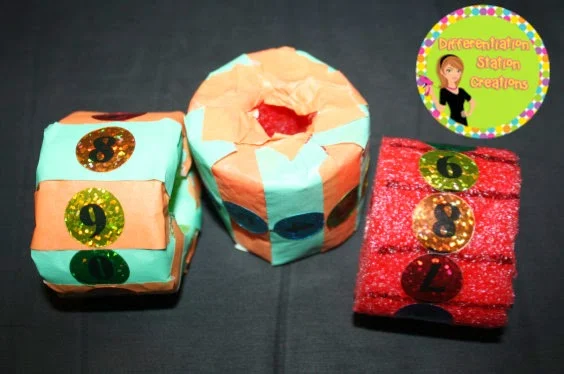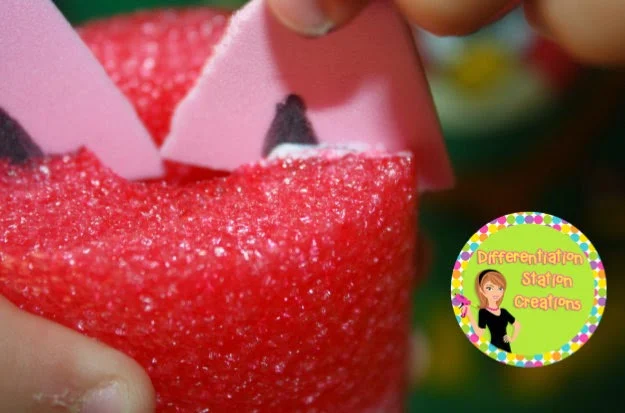I love PVC! I recently bought a bunch in bulk to make Mini Anchor Chart Stands. See them here. Now I have an abundance of PVC, so I had to get crackin' on what I could make out of it!
I've been working on tens and ones with one of the students that I tutor. He has a great deal of difficulty identifying how many tens and how many ones in any given number. We have to go back to building a strong number sense, but after awhile everything that I come up with is boring. I needed a new way to play with tens and ones.
We regularly use the rekenrek to build numbers 0-100. It is a great tool and visual for "seeing" the tens and ones. I use different variations, depending on the needs of the student. Below, are some different options. On the top, is my teacher or oversize version of the 20 rekenrek. I made this out of PVC, PVC elbows, and pool noodles. It is the same as the 20 rekenrek student version. There is also a 100 rekenrek and a 10 rekenrek. These rekenrek's are made out of carpet stair treads from the dollar store. I found the DIY directions from Jennifer Davis. I'm including the video below.
I use the 20 rekenrek with my student who is having difficulty with tens and ones. We went back to the beginning to identify 10's and 1's. We use both the oversize rekenrek and student version to play with numbers. I found a great resource from Barbara Blanke on "Using the Rekenrek as a Visual Model for Strategic Reasoning in Mathematics". She includes tons of strategies, activities, and printables for you to use. It is a wonderful resource.
I've been working on tens and ones with one of the students that I tutor. He has a great deal of difficulty identifying how many tens and how many ones in any given number. We have to go back to building a strong number sense, but after awhile everything that I come up with is boring. I needed a new way to play with tens and ones.
We regularly use the rekenrek to build numbers 0-100. It is a great tool and visual for "seeing" the tens and ones. I use different variations, depending on the needs of the student. Below, are some different options. On the top, is my teacher or oversize version of the 20 rekenrek. I made this out of PVC, PVC elbows, and pool noodles. It is the same as the 20 rekenrek student version. There is also a 100 rekenrek and a 10 rekenrek. These rekenrek's are made out of carpet stair treads from the dollar store. I found the DIY directions from Jennifer Davis. I'm including the video below.
Jennifer Davis also really explains the rekenrek very well! She made a video that explains and demonstrates how the rekenrek can really help students increase number fluency and subitizing skills. See her video here.
I created a rekenrek with 10 beads for my daughter. She just turned four and really loves playing and exploring with the rekenrek. Using the rekenrek, she made the connection that the five white beads match the five fingers on her left hand and the five pink beads match the fingers on her right hand. She is now subitizing numbers to 5. The real life connections and hands-on activities with math are helping her to create a strong number sense.
Here is an example of using the rekenrek in conjunction with the tens and one's manipulative. My student and I took turns making different numbers, to 20, on the Number Wheel. When a number was chosen, the other person had to represent the number on the rekenrek. We then identified how many 10's, if any, and how many 1's.
The "Number Wheel" is such fun, because it is almost like a game. It is set up kind of like a slot machine, because the numbers need to align with the tape across the top of the PVC elbows.
The "Number Wheel" is the perfect manipulative to pair with the 100 rekenrek. Students are able to physically build the number on the rekenrek and THEN physically build the number on the "Number Wheel". They are representing the number in objects, as well as, representing it as a numeral.
Here my student created the number 90 on the rekenrek and "Number Wheel". He is starting to make the connection between tens and ones.
Here is an example of 61.
You can also use the number wheel with base ten blocks. It is perfect to help students see the connection between the number and tens and ones. You could use it as a partner game, where one student made a number on the "Number Wheel" and the other physically made the number with base ten blocks. Perfect for identifying the number of tens and ones. It helps students transition from manipulatives to identifying tens and ones within the number itself.
Now for the DIY instructions.
Cut 2-3 pieces off of a pool noodle. Use three, if you would like to make hundreds, tens, and ones.
My pool noodle sections are about 2 inches across. I used a bread knife for a clean cut.
Originally, I just drew lines across the pool noodles, but did not like how the visual. It was too cluttered and not distinct enough.
I decided on using two different colors of masking tape. I alternated colors. Another bonus of the two colors, is that the odd numbers are all blue and the even numbers are orange.
I had to overlap the pieces of masking tape to have all ten numbers fit on the noodle. This is where the lines on the pool noodle came in handy. It gave me a template for fitting all the numbers on the noodle.
In these examples, I used brightly colored number stickers, but decided it was too distracting and went with a Sharpee.
One of the most important steps is adding a layer of hot glue to the ends of the pool noodles, after you tape them down. Make sure to have the tape overlap onto both edges of the pool noodle. Put a good amount of hot glue all around the outside of the hole. This will keep the tape down and make it more durable. Make sure to let the hot glue totally dry before flipping over. I made that mistake :)
If you are making a "Number Wheel" with tens and ones, cut a piece of 1/2 inch PVC pipe that is a little more that 5" long. If you are making a hundreds wheel, make the cut about 8" long.
I used a PCV saw with my mini anchor chart stands, but then got smart and bought a tool designed to cut PVC pipe. It was around $10 and is the best investment I've made.
It's super easy to snap through the PVC pipe.
After cutting the PVC pipe, you need two 1/2" PVC elbows. These elbows are 90 degrees. Attach an elbow to each end of the PVC pipe, after you add the number wheels.
I put a different colored piece of masking tape down the middle of each elbow. I also outlined the masking tape in Sharpee, to make it stand out. This is the visual stopping point for kids. This is like when the slot machine spins and all the pictures line up. This is the "winning" number!!
Put your number wheels on the PVC and you are ready to go! I love that the "Number Wheel" will sit flat on any surface. It is great for small groups, because they can place it flat on the table in front of them.
Here is the winning number 92! It is all lined up and easy to read!!!
Hope this manipulative works as well for you as it does for my students! I would love to hear your comments, ideas, and suggestions. I still have a ton of PVC pipe left to use. Any requests on manipulatives that you need in your classrooms? I would LOVE to try and create something that would work for you!






























































